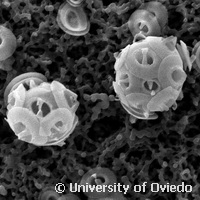Algae fossils shed light on adaptation to global warming
When thinking about global warming, one thing usually comes to mind: man-made CO2 emissions. Industrialisation single-handedly caused the rise of Earth's surface temperature, leading to the likes of shrinking glaciers, damaged ecosystems, desertification and increased scarcity of freshwater. While this prominent role cannot be questioned, some questions do remain regarding the exact consequences of global warming. But what is this all happened before? Aiming to improve scientific understanding of climate change, researchers of the EU-funded PACE (Precedents for Algal Adaptation to Atmospheric CO2: New Indicators for Eukaryotic Algal Response to the Last 60 Million Years of CO2 Variation) project have been digging into the past. Their study offers evidence of a very close link between the decrease of atmospheric CO2 and the cooling and glaciations during a period yet to be fully clear to scientists: between 10 and 2 million years ago. The researchers recently came up with a study entitled 'Late Miocene threshold response of marine algae to carbon dioxide limitation' that was published in Nature. This study provides the first-ever proof that the greenhouse effect brought about an increase in the temperatures during that period, which was warmer than today's climate and had the same range of CO2 concentrations currently expected for the end of the 21st century. Until now, the only direct measurements of CO2 levels were limited to the past 800,000 years and, while they demonstrated a close link between temperature and CO2, this was only based on data from periods colder than present. The new research was conducted by analyzing the history of marine algae's adaptation to increasing levels of CO2, which takes place much faster than what was previously thought. Algae are a good indicator for concentrations of CO2 in the atmosphere, since the latter is key to photosynthesis. When CO2 levels are low, photosynthesis may not proceed as rapidly, forcing plants to develop coping mechanisms. In algae, this mechanism consists in using and transporting other forms of carbon in the ocean such as bicarbonate. Since this approach requires extra energy and nutrients, algae might be expected to stop this extra accumulation when CO2 levels in the atmosphere increase. The researchers developed a new indicator which allowed them to track when algae stopped using one of these extra sources of carbon. Some algae make microscopic shells that accumulate on the sea floor - just like clams make shells that accumulate on the shore - which can be used to understand how these ancient algae coped with CO2 levels when they were alive. The results shed light not only on the adaptation of algae to CO2 but also on the history of CO2 in the atmosphere. A new model of how algal cells transport carbon shows that there is a change in the chemical makeup of the shells when the cell needs to use supplementary 'fuels' like bicarbonate in order to grow. By measuring the chemistry of fossil shells which grew in the ocean at different times over the past 60 million years, the authors demonstrated that algae started to rely heavily on these supplementary carbon sources relatively recently, between 7 and 5 million years ago. The emergence of the adaptation during that period is surprising, according to the researchers. Up until the Industrial Revolution, the earth´s climate had been slowly cooling for tens of millions of years, with ice caps emerging first on Antarctica 33 million years ago and then later on Greenland about 2.5 million years ago. The cooling has been broadly linked to a gradual weakening of the greenhouse effect as the atmosphere´s CO2 was slowly removed by natural processes. There is evidence for strong CO2 decreases 33 million years ago, coincident with the start of Antarctic glaciation. However, the history of atmospheric CO2 over the last 10 million years is surrounded by controversy, with many studies suggesting that CO2 levels over this period were low and constant despite long-term climate cooling. 'The results of the new study suggest that CO2 was declining and crossed a critical threshold between 7 and 8 million years, a result consistent with the evidence for ocean cooling,' notes Heather Stoll, co-author of the study. The study, conducted using sediments obtained from the Caribbean and South Atlantic Oceans, also suggests that algae adapt at levels of CO2 around 500 parts per million. Clara Bolton of the Department of Geology of the University of Oviedo, who also co-authored the study, explains, 'these levels will most likely be attained again later in this century due to fossil fuel use, and this adaptation may have consequences for the ecosystem in the surface ocean in the future.'For more information, please visit: PACE http://www.paceproject.eu/ Project factsheet University of Oviedo http://www.uniovi.es/
Countries
Spain



